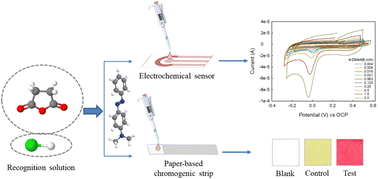A paper-based chromogenic strip and electrochemical sensor for the detection of 4-(dimethylamino)azobenzene†
Abstract
Natural and synthetic dyes are added to different food commodities to enhance their appearance and acceptance by consumers. Acute and chronic exposure owing to the consumption of non-permitted dyes may lead to health concerns such as allergic reactions, eczema, and asthma. 4-(Dimethylamino)azobenzene (4-DMAAB) is a non-permitted dye that has been reported in adulterated mustard oil. Consumption of 4-DMAAB poses severe risks due to its mutagenic and carcinogenic properties. Several sensitive methods such as FT-NIR, FT-MIR and SERS are available for the detection of 4-DMAAB. Here, a spectrophotometric method was developed for the detection of 4-DMAAB. The developed method was translated to a point-of-test paper-based, chromogenic strip which showed a detection limit of 0.025 mM for 4-DMAAB. Also, an electrochemical sensor was developed by electro-depositing the test solution on a screen-printed electrode. The electrochemical sensor showed an LOD of 0.027 ± 0.008 mM with recovery in the range of 91–107% of 4-DMAAB. Oil samples collected from the market were processed by liquid–liquid extraction and the content of 4-DMAAB was assessed. The developed point-of-use sensors for the detection of 4-DMAAB have potential for use by the consumers, food industry and regulatory agencies for on-site analysis and assuring the quality of edible oils.



 Please wait while we load your content...
Please wait while we load your content...